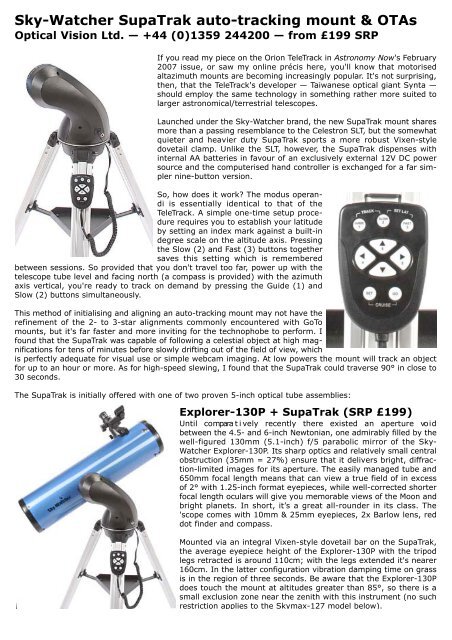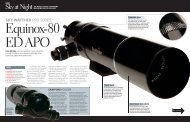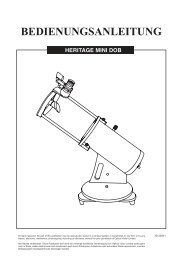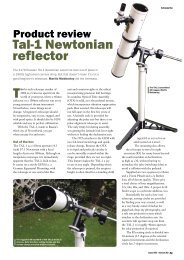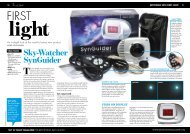Scopetest.com review of SupaTrak Telescopes ... - Optical Vision Ltd
Scopetest.com review of SupaTrak Telescopes ... - Optical Vision Ltd
Scopetest.com review of SupaTrak Telescopes ... - Optical Vision Ltd
You also want an ePaper? Increase the reach of your titles
YUMPU automatically turns print PDFs into web optimized ePapers that Google loves.
Sky-Watcher <strong>SupaTrak</strong> auto-tracking mount & OTAs<br />
<strong>Optical</strong> <strong>Vision</strong> <strong>Ltd</strong>. — +44 (0)1359 244200 — from £199 SRP<br />
If you read my piece on the Orion TeleTrack in Astronomy Now's February<br />
2007 issue, or saw my online précis here, you'll know that motorised<br />
altazimuth mounts are be<strong>com</strong>ing increasingly popular. It's not surprising,<br />
then, that the TeleTrack's developer — Taiwanese optical giant Synta —<br />
should employ the same technology in something rather more suited to<br />
larger astronomical/terrestrial telescopes.<br />
Launched under the Sky-Watcher brand, the new <strong>SupaTrak</strong> mount shares<br />
more than a passing resemblance to the Celestron SLT, but the somewhat<br />
quieter and heavier duty <strong>SupaTrak</strong> sports a more robust Vixen-style<br />
dovetail clamp. Unlike the SLT, however, the <strong>SupaTrak</strong> dispenses with<br />
internal AA batteries in favour <strong>of</strong> an exclusively external 12V DC power<br />
source and the <strong>com</strong>puterised hand controller is exchanged for a far simpler<br />
nine-button version.<br />
So, how does it work The modus operandi<br />
is essentially identical to that <strong>of</strong> the<br />
TeleTrack. A simple one-time setup procedure<br />
requires you to establish your latitude<br />
by setting an index mark against a built-in<br />
degree scale on the altitude axis. Pressing<br />
the Slow (2) and Fast (3) buttons together<br />
saves this setting which is remembered<br />
between sessions. So provided that you don't travel too far, power up with the<br />
telescope tube level and facing north (a <strong>com</strong>pass is provided) with the azimuth<br />
axis vertical, you're ready to track on demand by pressing the Guide (1) and<br />
Slow (2) buttons simultaneously.<br />
This method <strong>of</strong> initialising and aligning an auto-tracking mount may not have the<br />
refinement <strong>of</strong> the 2- to 3-star alignments <strong>com</strong>monly encountered with GoTo<br />
mounts, but it's far faster and more inviting for the technophobe to perform. I<br />
found that the <strong>SupaTrak</strong> was capable <strong>of</strong> following a celestial object at high magnifications<br />
for tens <strong>of</strong> minutes before slowly drifting out <strong>of</strong> the field <strong>of</strong> view, which<br />
is perfectly adequate for visual use or simple webcam imaging. At low powers the mount will track an object<br />
for up to an hour or more. As for high-speed slewing, I found that the <strong>SupaTrak</strong> could traverse 90° in close to<br />
30 seconds.<br />
The <strong>SupaTrak</strong> is initially <strong>of</strong>fered with one <strong>of</strong> two proven 5-inch optical tube assemblies:<br />
Explorer-130P + <strong>SupaTrak</strong> (SRP £199)<br />
Until <strong>com</strong>para t i vely recently there existed an aperture vo i d<br />
between the 4.5- and 6-inch Newtonian, one admirably filled by the<br />
well-figured 130mm (5.1-inch) f/5 parabolic mirror <strong>of</strong> the Sky-<br />
Watcher Explorer-130P. Its sharp optics and relatively small central<br />
obstruction (35mm = 27%) ensure that it delivers bright, diffraction-limited<br />
images for its aperture. The easily managed tube and<br />
650mm focal length means that can view a true field <strong>of</strong> in excess<br />
<strong>of</strong> 2° with 1.25-inch format eyepieces, while well-corrected shorter<br />
focal length oculars will give you memorable views <strong>of</strong> the Moon and<br />
bright planets. In short, it’s a great all-rounder in its class. The<br />
'scope <strong>com</strong>es with 10mm & 25mm eyepieces, 2x Barlow lens, red<br />
dot finder and <strong>com</strong>pass.<br />
Mounted via an integral Vixen-style dovetail bar on the <strong>SupaTrak</strong>,<br />
the average eyepiece height <strong>of</strong> the Explorer-130P with the tripod<br />
legs retracted is around 110cm; with the legs extended it's nearer<br />
160cm. In the latter configuration vibration damping time on grass<br />
is in the region <strong>of</strong> three seconds. Be aware that the Explorer-130P<br />
does touch the mount at altitudes greater than 85°, so there is a<br />
small exclusion zone near the zenith with this instrument (no such<br />
restriction applies to the Skymax-127 model below).
Skymax-127 + <strong>SupaTrak</strong> (SRP £ 299)<br />
At just 33cm long and 14cm in diameter, the 127mm aperture<br />
f/12 Skymax-127 still packs a performance punch with a relatively<br />
short cool-down time for a 'scope <strong>of</strong> this type. The<br />
largest Maksutov-Cassegrain in the standard range (only the<br />
150mm and 180mm Pro Series instruments are larger), this is<br />
one <strong>of</strong> the jewels in the Sky-Watcher crown. It's large enough<br />
to produce richly detailed, high-contrast lunar and planetary<br />
images, yet doesn't overtax smaller mounts like the <strong>SupaTrak</strong>.<br />
The Skymax-127's standard Vixen dovetail rail also ensures its<br />
<strong>com</strong>patibility with a wide range <strong>of</strong> other mounts. The 'scope<br />
<strong>com</strong>es with 10mm & 25mm eyepieces, a 2x Deluxe Barlow<br />
lens, 6x30 finder, erect image star diagonal and <strong>com</strong>pass.<br />
One might not consider the Skymax-127 for daytime terrestrial<br />
use, but the instrument <strong>com</strong>es with an erect image diagonal<br />
and is quite capable <strong>of</strong> focusing down to 8 metres with minimal<br />
image shift. The bright and sharp 6x30 finder sensibly <strong>com</strong>es<br />
on a longer bracket <strong>of</strong>fering plenty <strong>of</strong> clearance from the OTA.<br />
Its internal baffle diameter <strong>of</strong> just under 23mm means that the<br />
Skymax-127 is a strictly 1.25-inch format instrument. While it<br />
hardly excels as a wide-field 'scope, it can still deliver a crisp<br />
3⁄4° field with low power eyepieces.<br />
As with all catadioptric 'scopes, I wished that the manufacturer<br />
bundled a dewshield with the Skymax-127. With the<br />
<strong>SupaTrak</strong>'s tripod legs retracted the average eyepiece height is<br />
close to 75cm, extending to about 130cm at full height.<br />
Vibration time on grass at full tripod extension is around two<br />
seconds.<br />
Conclusions<br />
A slightly heavier-duty tripod with tubular steel legs would've been nicer, but despite appearances the aluminium<br />
one supplied is adequately stable as demonstrated by the short vibration times. For novice and expert<br />
alike, if you are looking for an intuitive and far less intimidating user experience than that <strong>of</strong>fered by cheaper<br />
GoTo mounts, the <strong>SupaTrak</strong> is highly re<strong>com</strong>mended as a versatile grab-and-go system, particularly with this<br />
well-matched pair <strong>of</strong> optical tube assemblies.<br />
© 2007 Ade Ashford & ScopeTest.<strong>com</strong>


